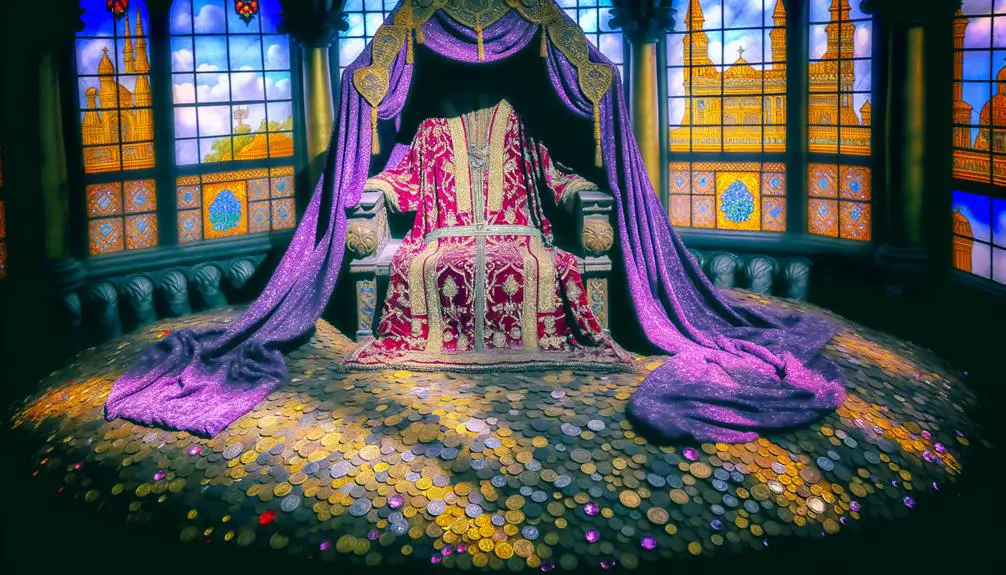Harness the hidden meanings of colors in the Bible to uncover deeper spiritual insights and divine symbolism.

Color in the Bible
In the Bible, colors aren't merely aesthetic; they're imbued with profound symbolism. Red denotes the sanctity of sacrifice, often linked to the sacrificial lamb's blood in Exodus, while blue signifies divine revelation, evident in the high priests' robes and the heavenly visions described. White epitomizes purity and holiness, used to indicate spiritual transcendence. Green relates to life and divine restoration, depicted through verdant pastures in Psalms. Purple symbolizes royalty and wealth, reflecting the status of biblical figures adorned in purple garments. Each color conveys thoughtful themes that reinforce spiritual messages, offering further insights into biblical teachings.
Key Takeaways
- Red in the Bible symbolizes sacrifice and divine retribution in warfare.
- Blue represents divine revelation and is linked to God's commandments.
- White is associated with purity, holiness, and divine grace.
- Green signifies life, restoration, and spiritual growth.
- Purple denotes royalty, wealth, and high status in biblical narratives.
Significance of Red: Sacrifice and War

In the biblical context, red symbolizes both the sanctity of sacrifice and the harsh reality of war. You'll find that this vivid hue permeates scripture, carrying with it a deep emotional resonance that underscores critical narratives. Consider how red is used to signify the blood of the lamb in Exodus during the Passover. This isn't just a color; it's a symbol of life preserved, a profound element of sacrifice that speaks to deliverance and redemption.
Red's appearance in the Bible isn't confined to themes of salvation alone; it also encapsulates the brutal truths of human conflict. The prophetic books, for instance, often employ red to depict the bloodshed and destruction inherent in warfare. Here, the color shifts from a symbol of divine protection to one of divine retribution or warning.
Moreover, the use of red in passion imagery—such as in the suffering of Christ or the martyrs—intensifies its impact, making the narratives not just stories to be read but felt. Through these examples, you'll notice how red not only narrates but also evokes, rendering the spiritual and emotional landscapes of the Bible in vivid strokes that resonate deeply within the human psyche.
Blue: A Symbol of Divine Revelation
Shifting focus to the color blue, we find it deeply embedded in biblical texts as a symbol of divine revelation and spiritual truth. This hue isn't just another color; it's a profound marker of the communication between the divine and humanity, often representing heavenly guidance. Let's explore the significance of blue in the scriptures, where it serves not merely as an aesthetic choice but as a complex symbol imbued with deep theological meaning.
- Presence in the Tabernacle: Blue was used extensively in the fabric of the Tabernacle, signifying the direct intervention and presence of God among His people.
- Priestly Garments: High priests wore blue robes, symbolizing their unique role as intermediaries between God and Israel, channeling divine wisdom and revelations.
- Artistic Representation: In religious art, blue often cloaks holy figures, highlighting their divine connection and role in conveying spiritual truths.
- Symbol of the Law: Blue threads in tzitzit (Jewish prayer shawls) remind wearers of God's commandments, linking the color to divine law and guidance.
- Visions of Heaven: Descriptions of heavenly visions frequently include blue, reflecting its association with the spiritual domain and the mysteries of faith.
Through these elements, blue emerges not just as a color but as a dynamic symbol of divine interaction and revelation in biblical literature.
White: Purity and Holiness

In examining the color white within biblical texts, you'll find it frequently symbolizes purity and holiness, reflecting an absence of sin and a state of divine grace. As you explore the symbolism of white, consider how its portrayal can vary, from the radiant garments of angels to the cleansing leprosy of Naaman. Analyzing these biblical references will reveal how white isn't just a color, but a powerful emblem of spiritual ideals and transformation.
Symbolism of White
White, often associated with purity and holiness, is a recurring symbol throughout the Bible that reflects divine perfection and the righteousness of God. This symbolism isn't just abstract; it manifests concretely in narratives and descriptions. You'll notice that white isn't merely a color but a significant emblem within the scriptural texts.
- White Garments: Symbolize purity and are often worn during pivotal spiritual transformations or revelations.
- Angelic Appearances: Angels are frequently depicted adorned in white, emphasizing their divine nature and heavenly origin.
- Cleansing Rituals: White plays an important role, suggesting purification from sin and unrighteousness.
- Visions of Godliness: Prophetic visions often use white to depict the holy and untainted.
- Spiritual Transcendence: White underscores the passage from earthly to divine states, marking a clear distinction in sanctity.
Biblical References to White
Building on the symbolism previously discussed, let's now explore specific biblical passages where white underscores themes of purity and holiness. In the Book of Revelation, white garments symbolize the righteous deeds of God's faithful (Revelation 19:8). This imagery isn't merely decorative; it serves as a profound metaphor for spiritual renewal and moral purity. Similarly, in Leviticus, the purification process for leprosy involves two clean birds, cedar wood, scarlet yarn, and hyssop, culminating in the afflicted person being cleansed and donning white garments (Leviticus 14:4-9). The symbolism here is intricate; leprosy represents sin's corruption, and the white garments signify restored purity, underscoring a thematic throughline where white consistently heralds redemption and sanctification.
Green: Life and Restoration
Green symbolizes life and restoration throughout the Biblical narrative, reflecting God's renewal of both the natural world and human spirits. This vivid color often heralds green growth and verdant renewal, echoing the themes of rebirth and new beginnings. In the scripture, green is not merely a color but a symbol deeply interwoven with the cycles of life.
The presence of green in the Bible can be seen as both a literal and metaphorical representation:
- Creation: Green is prominently featured in the Genesis account, where vegetation is created to cover the earth, symbolizing the foundational life-giving force of God's creation.
- Restoration: The prophets, like Isaiah, speak of deserts blossoming with greenery as a sign of divine restoration and peace.
- Eternal Life: In the Psalms, green pastures are described as places of safety and sustenance, provided by God to those who follow Him.
- Spiritual Growth: Paul uses the imagery of planting and watering green plants to depict spiritual growth among believers.
- Hope: The renewal of life each spring, which turns landscapes green, serves as a perennial reminder of hope and God's promise of renewal.
Each of these instances underscores the profound layers of meaning associated with the color green in the Biblical texts, inviting you to reflect on the continuous cycle of life and restoration that it represents.
Purple: Royalty and Wealth

While green reflects the natural and spiritual renewal, purple in the Bible symbolizes royalty and wealth, highlighting the status and power associated with this vibrant color. In ancient times, purple textiles were a mark of high status, frequently mentioned in scriptures to signify wealth and distinction. The rarity and cost of Tyrian dye, derived from the murex shellfish, made purple fabric exceptionally valuable and reserved for the elite.
You'll see that in biblical narratives, characters adorned in purple are often those of high rank or significant wealth. For instance, in the Book of Judges, the kings of Midian wear purple garments, symbolizing their royal standing and the wealth of their kingdoms. Similarly, in the Gospel of Luke, the rich man is described as clothed in purple and fine linen, further illustrating how purple is used to denote opulence and luxury.
The process of producing Tyrian dye was labor-intensive and costly, involving thousands of shellfish for just a few ounces of dye, which is why purple became a symbol of not just wealth but also power and authority. This exclusivity made purple textiles a clear indicator of social status, reinforcing the association between this color and the societal elite in biblical texts.
Black and Darkness: Judgment and Death
In biblical texts, black and darkness often symbolize judgment and death, reflecting the profound spiritual and physical implications of these motifs. You'll find that darkness isn't just a lack of light; it's a profound symbol loaded with meaning. The narrative of the Bible uses these colors and themes to convey the severity and finality of divine judgment.
Consider how darkness symbolism and judgment representations permeate biblical stories:
- Exodus 10:21-23: The Plague of Darkness, a physical manifestation of God's judgment on Egypt, emphasizes total isolation from light and divine presence.
- Job 3:5: Job curses the day of his birth, wishing for it to be engulfed in darkness, symbolizing his deep suffering and the judgment he feels from his circumstances.
- Jeremiah 13:16: A warning to give glory to God before He causes darkness, indicating impending judgment for unrepentant behaviors.
- Matthew 27:45: During the crucifixion, darkness covers the land, symbolizing the judgment and the weight of the world's sins being placed upon Christ.
- Revelation 16:10: The fifth bowl judgment, where darkness represents the culmination of God's wrath.
These instances show how blackness and darkness aren't just descriptive elements but are integral to understanding biblical teachings on judgment and mortality.
Gold and Silver: Glory and Redemption

Shifting focus to the brighter spectrum, gold and silver in the Bible often symbolize glory and redemption, reflecting divine favor and the promise of salvation. These metals aren't just literal treasures; they carry a profound metaphorical weight. Gold, with its incorruptible shine, is frequently associated with divine wealth, a visual representation of an eternal, unblemished kingdom. It's used extensively in descriptions of the New Jerusalem, where streets of transparent gold signify a perfected state beyond corruption.
Silver, while also valuable, often underscores the idea of redemption through its historical and ritual use. For instance, silver was required for the redemption of a firstborn son in ancient Hebrew practices, embodying the concept of being bought back or redeemed, which resonates with the New Covenant themes of redemption through Christ.
The juxtaposition of these metals within scriptural narratives highlights a tension between divine wealth and material transience. While gold depicts an eternal glory, silver's susceptibility to tarnish can remind you of the ephemeral nature of worldly possessions, urging a focus on spiritual wealth. Therefore, these elements together weave a complex tapestry of temporal and eternal pursuits within biblical theology.
Frequently Asked Questions
How Did Culture Influence the Use of Colors in Biblical Texts?
Cultural metaphors and ritual significance shaped color usage in historical texts. You'd find that societies infused colors with specific meanings, which deeply influenced how they were represented in sacred and literary works.
Are There Any Colors Associated With Specific Biblical Figures?
You'll find that certain hues are closely tied to notable figures, reflecting color symbolism meanings and visual representation trends. This connection offers deep, scholarly insight into character portrayal and thematic elements.
How Do Translations Impact the Interpretation of Colors?
Translations can greatly influence your understanding of texts due to varying translation accuracy and linguistic evolution. Subtle shifts in language impact the perception and meaning of words, potentially altering interpretations in meaningful ways.
Were Colors Used Symbolically in Non-Religious Ancient Texts?
Yes, colors were symbolically used in non-religious ancient texts. Ancient inscriptions and mythological chromatics often employed color symbolism to convey complex ideas or attributes associated with gods, power, or the natural world.
How Did Historical Availability of Pigments Affect Color Symbolism?
The historical availability of pigments, influenced by pigment trade routes and technological advancements, greatly shaped color symbolism, as you'd see in various cultures valuing certain hues based on their rarity and accessibility.



Sign up